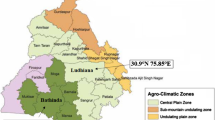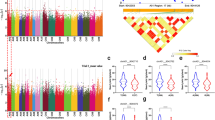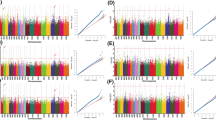Abstract
Key message
A set of additive loci for seed oil content were identified using association mapping and one of the novel loci on the chromosome A5 was validated by linkage mapping.
Abstract
Increasing seed oil content is one of the most important goals in the breeding of oilseed crops including Brassica napus, yet the genetic basis for variations in this important trait remains unclear. By genome-wide association study of seed oil content using 521 B. napus accessions genotyped with the Brassica 60K SNP array, we identified 50 loci significantly associated with seed oil content using three statistical models, the general linear model, the mixed linear model and the Anderson–Darling test. Together, the identified loci could explain approximately 80 % of the total phenotypic variance, and 29 of these loci have not been reported previously. Furthermore, a novel locus on the chromosome A5 that could increase 1.5–1.7 % of seed oil content was validated in an independent bi-parental linkage population. Haplotype analysis showed that the favorable alleles for seed oil content exhibit cumulative effects. Our results thus provide valuable information for understanding the genetic control of seed oil content in B. napus and may facilitate marker-based breeding for a higher seed oil content in this important oil crop.






Similar content being viewed by others
References
Altschul SF, Gish W, Miller W, Myers EW, Lipman DJ (1990) Basic local alignment search tool. J Mol Biol 215:403–410
Atwell S, Huang YS, Vilhjálmsson BJ et al (2010) Genome-wide association study of 107 phenotypes in Arabidopsis thaliana inbred lines. Nature 465:627–631
Bancroft I, Morgan C, Fraser F et al (2011) Dissecting the genome of the polyploid crop oilseed rape by transcriptome sequencing. Nat Biotechnol 29:762–766
Baud S, Lepiniec L (2010) Physiological and developmental regulation of seed oil production. Prog Lipid Res 49:235–249
Bradbury PJ, Zhang Z, Kroon DE, Casstevens TM, Ramdoss Y, Buckler ES (2007) TASSEL: software for association mapping of complex traits in diverse samples. Bioinformatics 23:2633–2635
Bus A, Körber N, Snowdon RJ, Stich B (2011) Patterns of molecular variation in a species-wide germplasm set of Brassica napus. Theor Appl Genet 123:1413–1423
Cai G, Yang Q, Yi B, Fan C, Edwards D, Batley J, Zhou Y (2014) A complex recombination pattern in the genome of allotetraploid Brassica napus as revealed by a high-density genetic map. PLoS ONE 9:e109910
Chalhoub B, Denoeud F, Liu S et al (2014) Early allopolyploid evolution in the post-Neolithic Brassica napus oilseed genome. Science 345:950–953
Churchill GA, Doerge RW (1994) Empirical threshold values for quantitative trait mapping. Genetics 138:963–971
Delourme R, Falentin C, Huteau V, Clouet V, Horvais R, Gandon B, Specel S, Hanneton L, Dheu J, Deschamps M (2006) Genetic control of oil content in oilseed rape (Brassica napus L.). Theor Appl Genet 113:1331–1345
Ding J, Ali F, Chen G, Li H, Mahuku G, Yang N, Narro L, Magorokosho C, Makumbi D, Yan J (2015) Genome-wide association mapping reveals novel sources of resistance to northern corn leaf blight in maize. BMC Plant Biol 15:206
Donini P, Chen S, Nelson M, Ghamkhar K, Fu T, Cowling W (2007) Divergent patterns of allelic diversity from similar origins: the case of oilseed rape (Brassica napus L.) in China and Australia. Genome 51:1–10
Drenkard E, Richter BG, Rozen S, Stutius LM, Angell NA, Mindrinos M, Cho RJ, Oefner PJ, Davis RW, Ausubel FM (2000) A simple procedure for the analysis of single nucleotide polymorphisms facilitates map-based cloning in Arabidopsis. Plant Physiol 124:1483–1492
Evanno G, Regnaut S, Goudet J (2005) Detecting the number of clusters of individuals using the software STRUCTURE: a simulation study. Mol Ecol 14:2611–2620
Excoffier L, Lischer HE (2010) Arlequin suite ver 3.5: a new series of programs to perform population genetics analyses under Linux and Windows. Mol Ecol Resour 10:564–567
Gan L, Sun X, Jin L, Wang G, Xiu J, Wei Z, Fu T (2003) Establishment of math models of NIRS analysis for oil and protein contents in seed of Brassica napus. Sci Agric Sin 36:1609–1613
Hardy OJ, Vekemans X (2002) SPAGeDi: a versatile computer program to analyse spatial genetic structure at the individual or population levels. Mol Ecol Notes 2:618–620
Harper AL, Trick M, Higgins J, Fraser F, Clissold L, Wells R, Hattori C, Werner P, Bancroft I (2012) Associative transcriptomics of traits in the polyploid crop species Brassica napus. Nat Biotechnol 30:798–802
Hatzig SV, Frisch M, Breuer F, Nesi N, Ducournau S, Wagner M-H, Leckband G, Abbadi A, Snowdon RJ (2015) Genome-wide association mapping unravels the genetic control of seed germination and vigor in Brassica napus. Front Plant Sci 6:221
Huang X, Wei X, Sang T et al (2010) Genome-wide association studies of 14 agronomic traits in rice landraces. Nat Genet 42:961–967
Huang X, Zhao Y, Wei X et al (2012) Genome-wide association study of flowering time and grain yield traits in a worldwide collection of rice germplasm. Nat Genet 44:32–39
Ihaka R, Gentleman R (1996) R: a language for data analysis and graphics. J Comput Graph Statist 5:299–314
Jakobsson M, Rosenberg NA (2007) CLUMPP: a cluster matching and permutation program for dealing with label switching and multimodality in analysis of population structure. Bioinformatics 23:1801–1806
Jiang C, Shi J, Li R, Long Y, Wang H, Li D, Zhao J, Meng J (2014) Quantitative trait loci that control the oil content variation of rapeseed (Brassica napus L.). Theor Appl Genet 127:957–968
Kump KL, Bradbury PJ, Wisser RJ et al (2011) Genome-wide association study of quantitative resistance to southern leaf blight in the maize nested association mapping population. Nat Genet 43:163–168
Li H, Peng Z, Yang X et al (2013) Genome-wide association study dissects the genetic architecture of oil biosynthesis in maize kernels. Nat Genet 45:43–50
Li F, Chen B, Xu K, Wu J et al (2014) Genome-wide association study dissects the genetic architecture of seed weight and seed quality in rapeseed (Brassica napus L.). DNA Res 21:355–367
Li-Beisson Y, Shorrosh B, Beisson F et al (2013) Acyl-lipid metabolism. Arabidopsis Book 11:e0161
Lincoln SE, Daly MJ, Lander ES (1993) Constructing genetic linkage maps with MAPMAKER/EXP Version 3.0: a tutorial and reference manual. Whitehead Institute Technical Report. Whitehead Institute, Cambridge
Liu K, Muse SV (2005) PowerMarker: an integrated analysis environment for genetic marker analysis. Bioinformatics 21:2128–2129
Liu Y, Wang L, Deng M, Li Z, Lu Y, Wang J, Wei Y, Zheng Y (2015) Genome-wide association study of phosphorus-deficiency-tolerance traits in Aegilops tauschii. Theor Appl Genet 128:2203–2212
Long AD, Langley CH (1999) The power of association studies to detect the contribution of candidate genetic loci to variation in complex traits. Genome Res 9:720–731
Mohammadi M, Blake TK, Budde AD, Chao S, Hayes PM, Horsley RD, Obert DE, Ullrich SE, Smith KP (2015) A genome-wide association study of malting quality across eight US barley breeding programs. Theor Appl Genet 128:705–721
Murray M, Thompson WF (1980) Rapid isolation of high molecular weight plant DNA. Nucleic Acids Res 8:4321–4326
Nei M (1972) Genetic distance between populations. Am Nat 106:283–292
Pritchard JK, Stephens M, Donnelly P (2000) Inference of population structure using multilocus genotype data. Genetics 155:945–959
Qian W, Meng J, Li M, Frauen M, Sass O, Noack J, Jung C (2006) Introgression of genomic components from Chinese Brassica rapa contributes to widening the genetic diversity in rapeseed (B. napus L.), with emphasis on the evolution of Chinese rapeseed. Theor Appl Genet 113:49–54
Qian L, Qian W, Snowdon RJ (2014) Sub-genomic selection patterns as a signature of breeding in the allopolyploid Brassica napus genome. BMC Genom 15:1170
Schuler GD (1997) Sequence mapping by electronic PCR. Genome Res 7:541–550
Sun M, Hua W, Liu J, Huang S, Wang X, Liu G, Wang H (2012) Design of new genome-and gene-sourced primers and identification of QTL for seed oil content in a specially high-oil Brassica napus cultivar. PLoS ONE 7:e47037
Tian F, Bradbury PJ, Brown PJ, Hung H, Sun Q, Flint-Garcia S, Rocheford TR, McMullen MD, Holland JB, Buckler ES (2011) Genome-wide association study of leaf architecture in the maize nested association mapping population. Nat Genet 43:159–162
Trick M, Long Y, Meng J, Bancroft I (2009) Single nucleotide polymorphism (SNP) discovery in the polyploid Brassica napus using Solexa transcriptome sequencing. Plant Biotechnol J 7:334–346
USDA ERS (2014) Oil crops yearbook. http://www.ers.usda.gov/data-products/oil-crops-yearbook.aspx
Van Ooijen J (2009) MapQTL® 6, Software for the mapping of quantitative trait in experiment populations of diploid species. Kyazma B V, Wageningen
Wang X, Wang H, Long Y et al (2013) Identification of QTLs associated with oil content in a high-oil Brassica napus cultivar and construction of a high-density consensus map for QTLs comparison in B. napus. PLoS ONE 8:e80569
Wang N, Li F, Chen B et al (2014) Genome-wide investigation of genetic changes during modern breeding of Brassica napus. Theor Appl Genet 127:1817–1829
Wen W, Li D, Li X et al (2014) Metabolome-based genome-wide association study of maize kernel leads to novel biochemical insights. Nat Commun 5:3438
Wu J, Cai G, Tu J, Li L, Liu S, Luo X, Zhou L, Fan C, Zhou Y (2013) Identification of QTLs for resistance to Sclerotinia stem rot and BnaC. IGMT5. a as a candidate gene of the major resistant QTL SRC6 in Brassica napus. PLoS ONE 8:e67740
Yan J, Warburton M, Crouch J (2011) Association mapping for enhancing maize (Zea mays L.) genetic improvement. Crop Sci 51:433–449
Yang J, Lee SH, Goddard ME, Visscher PM (2011a) GCTA: a tool for genome-wide complex trait analysis. Am J Hum Genet 88:76–82
Yang X, Gao S, Xu S, Zhang Z, Prasanna BM, Li L, Li J, Yan J (2011b) Characterization of a global germplasm collection and its potential utilization for analysis of complex quantitative traits in maize. Mol Breed 28:511–526
Yang N, Lu Y, Yang X, Huang J, Zhou Y, Ali F, Wen W, Liu J, Li J, Yan J (2014) Genome wide association studies using a new nonparametric model reveal the genetic architecture of 17 agronomic traits in an enlarged maize association panel. PLoS Genet 10:e1004573
Yu J, Buckler ES (2006) Genetic association mapping and genome organization of maize. Curr Opin Biotech 17:155–160
Yu J, Pressoir G, Briggs WH et al (2006) A unified mixed-model method for association mapping that accounts for multiple levels of relatedness. Nat Genet 38:203–208
Zhao J, Becker HC, Zhang D, Zhang Y, Ecke W (2005) Oil content in a European × Chinese rapeseed population. Crop Sci 45:51–59
Zhao K, Aranzana MJ, Kim S et al (2007) An Arabidopsis example of association mapping in structured samples. PLoS Genet 3:e4
Zhao K, Tung C-W, Eizenga GC et al (2011) Genome-wide association mapping reveals a rich genetic architecture of complex traits in Oryza sativa. Nat Commun 2:467
Zhao J, Huang J, Chen F et al (2012) Molecular mapping of Arabidopsis thaliana lipid-related orthologous genes in Brassica napus. Theor Appl Genet 124:407–421
Zhu C, Gore M, Buckler ES, Yu J (2008) Status and prospects of association mapping in plants. Plant Genome 1:5–20
Zou J, Jiang C, Cao Z, Li R, Long Y, Chen S, Meng J (2010) Association mapping of seed oil content in Brassica napus and comparison with quantitative trait loci identified from linkage mapping. Genome 53:908–916
Acknowledgments
The work was financially supported by the funding from the Ministry of Science and Technology of China (2015CB150200, 2014DFA32210), Ministry of Agriculture of China (nycytx-00503 and 948 project (2011-G23)).
Author information
Authors and Affiliations
Corresponding author
Ethics declarations
Conflict of interest
The authors declare that they have no conflict of interest.
Ethical standards
The authors declare that this study complies with the current laws of the country in which the experiments were performed.
Additional information
Communicated by I. Parkin.
Electronic supplementary material
Below is the link to the electronic supplementary material.
Figure S1
Clustering strategy improves genotyping efficiency. (a) Automatic SNP calling using GenomeStudio software. (b) Corrected SNP calling according to parent/F1 triads. P1, P2, and F1 indicate representative samples with parent/F1 relationships. The three highlighted clusters denote the areas where the three different genotypes, homozygous allele AA (red), heterozygous AB (purple) and homozygous allele BB (blue), are called. Allele calls that are ambiguously located in the lighter colored areas between these areas are scored as “no call” (black) (TIFF 3052 kb)
Figure S2
Principal component analysis (PCA) of 521 rapeseed accessions based on (a) 31,090 SNPs without manual editing and (b) 4,595 SNPs recovered by manual editing. Each individual is represented by one dot and different color are corresponding to the population structure inferred by STRUCTURE (TIFF 1542 kb)
Figure S3
Principal component analysis (PCA) of 521 rapeseed accessions based on 25,870 SNPs. The first two principal components are shown. Each individual is represented by one dot and the color label corresponding to their classification: (a) the population structure inferred by STRUCTURE, (b) different growth type and (c) different geographic distribution (TIFF 4290 kb)
Figure S4
Neighbor-joining phylogenetic tree based on Nei’s genetic distance (TIFF 5706 kb)
Figure S5
Distribution of pairwise relative kinship estimates between rapeseed accessions (TIFF 468 kb)
Figure S6
Linkage disequilibrium (LD) decay across the 19 chromosomes of B. napus (TIFF 1997 kb)
Figure S7
Comparison of seed oil content of three environments. The two environments are plotted against each other, with their Pearson’s coefficients indicated (TIFF 1129 kb)
Figure S8
Box plots of seed oil content in the association panel grouped by population structure. The middle line indicates the median, the plus sign indicates the mean, the box indicates the range of the 25th to 75th percentiles of the total data, and the whiskers indicate the minimum and maximum values (TIFF 1138 kb)
Rights and permissions
About this article
Cite this article
Liu, S., Fan, C., Li, J. et al. A genome-wide association study reveals novel elite allelic variations in seed oil content of Brassica napus . Theor Appl Genet 129, 1203–1215 (2016). https://doi.org/10.1007/s00122-016-2697-z
Received:
Accepted:
Published:
Issue Date:
DOI: https://doi.org/10.1007/s00122-016-2697-z




